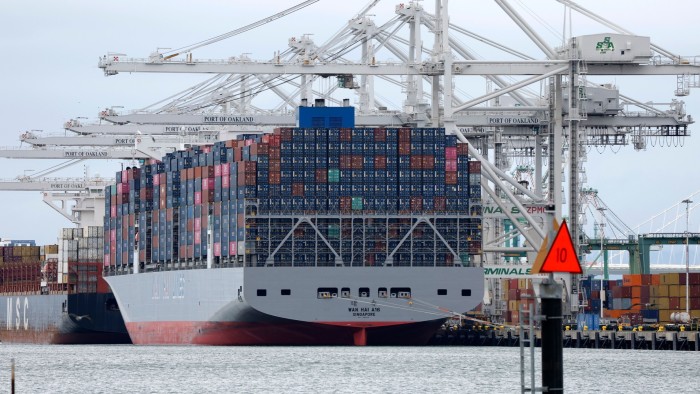Unlock the Editor’s Digest for free
Roula Khalaf, Editor of the FT, selects her favourite stories in this weekly newsletter.
Greetings. Last week, I wrote about US President Donald Trump’s administrative self-coup (or autogolpe) — his orders to the executive branch to arrogate the power of the purse that the Constitution grants to the legislature. While the most offending memo was withdrawn once chaos erupted, I argued that the constitutional and political crisis it launched would not go away. And so it has proved with subsequent events.
Elon Musk’s takeover of the US Treasury this week — his “Department of Government Efficiency” (Doge) employees have reportedly muscled their way into accessing the Treasury’s technical payment interface with the banking system and the general population — bears this out. As a blog post by Nathan Tankus explains, this poses extreme risk of abuse or technical breakdown which makes the constitutional crisis over spending even more severe than it seemed last week. It is only a matter of time, it seems, before Doge can stop federal payments it doesn’t like without having to convince a constitutionally minded agency to halt payment authorisations.
If you think “constitutional crisis” is crying wolf, don’t take it from me but read this stark warning written jointly by two former top government lawyers, one Democrat and one Republican. Attempts to “effectuate radical constitutional change” are what we’re up against, and that should be at the forefront of our minds whichever policy area we are contemplating.
The area given most attention in mainstream publications over the past week has not been the takeover of the Treasury’s financial plumbing, but Trump’s tariff announcements. Read on for my thoughts on how the rest of the world should handle them, knowing the magnitude of the system change Trump’s team is trying to engineer.
Over the weekend, Trump announced 25 per cent tariffs on Canada and Mexico, before they were abruptly suspended after phone calls with those countries’ leaders. An additional 10 per cent tariff on China has also been announced, but who knows what may have changed by the time this column hits the FT website. Through it all, EU leaders try nervously to guess what tariffs Trump will soon impose on the bloc (when they are not waiting to see if he really wants to invade Greenland).
It is frankly difficult to keep up. So spare a thought for my news-reporting colleagues who diligently report US policy only to find it has been changed as soon as they publish. But there is method in this madness: the speed (or “flooding of the zone”, in the words of Steve Bannon, whose interview with the New York Times is well worth reading) is designed to disorientate and paralyse. The right response is to lift our glance to the horizon, formulate long-term strategies and not miss the wood for the trees.
I don’t mean policymakers can ignore Trump’s immediate trade moves, even if those change by the day. Do check out a fantastic new resource my FT data colleagues have put together: the Trump tracker, where you can drill down to individual executive orders and tariffs and trade data for specific products. Martin Wolf’s column earlier this week was as good a summary as you can get of how to think about the latest tariff salvo, citing in part estimates from the Peterson Institute for International Economics of how costly it could be. In short, Mexico and Canada are so dependent on trade with the US that they are bound to get badly hurt nearly no matter what happens (see chart below).
I do agree with Martin that they have to stand firm — the export tax on Canadian oil sales to the US that he suggests would be just the ticket — and hit back if Trump does indeed tear up the deal he himself struck with them five years ago. But this will be costly to the retaliators. Meanwhile, China has announced a modest retaliation — Unhedged has useful details.
Everyone else is now also having to decide how to respond when they find themselves in “Tariff Man’s” crosshairs. Retaliate, and if so how? Or cajole Trump into relenting by offering something he is known to want, whether soldiers on a border or purchases of US natural gas? But there is another, longer-term, question that the US’s trade partners (if that hasn’t become a misnomer) need to make sure they don’t forget in the focus on immediate decisions. That is how they would fare if their trade with the US shrank or disappeared more or less indefinitely.
There are at least two reasons to ask this. One is that it clarifies the degree of leverage: is it possible to pre-empt Trump by willingly or even pre-emptively embracing a trade war (but risk a long-term disruption to trade)? You could, for example, hit Trump with national security-driven trade measures even before he carries out his own tariffs threats. Another reason is that no or little trade is the ultimate “outside option” — the worst-case scenario (in the trade sphere at least) that countries risk if they refuse to concede to whatever the US demands. If Trump is trying to play chicken, you need to know how great the cost is in case of a crash — and then work hard to reduce the pain for yourself in that scenario, thereby improving your outside option.
The answer is, for most countries, “big — but perhaps not disastrously big”. The chart below shows the world’s 20 biggest economies’ exports to the US as a share of their respective annual national income. It underlines how Mexico and Canada are uniquely exposed: more than one-quarter and one-fifth of their respective economic activity is geared towards selling to the US.
South Korea is a distant third, with an exposure of just over 6 per cent of GDP. But even exporting powerhouses Germany, Japan, Italy (!) and China are only about 3 per cent. That is to say, if all their exports to the US were halted in a trade war, about 3 per cent of GDP would disappear directly. Of course, there would be further repercussions, and some production would be diverted to other markets or import substitution. But it seems comparable to a bad recession and milder than the Covid-19 shock. And that is a worst-case scenario. If it happened over a stretched-out time rather than overnight, adaptation and substitution would mitigate more of the loss. My colleague Alan Beattie has previously cited estimates that most countries could find new markets within a few years. In his latest piece, however, he warns that missing out on the ever-hungrier US consumer would be a challenge for global producers. (On the other hand, other aspects of Trumponomics, like tax cuts and dollar strengthening, would sustain US import demand. How Trump will resolve this contradiction is anyone’s guess.)
For EU countries especially, which together run a huge trade surplus, the adaptation that makes most sense is not trying to redirect homeless exports to new markets, but redirecting the resources that produce them into new production for the structural transformation needed at home.
This is why my colleague Patricia Nilsson’s article about how German arms manufacturers are taking on workers laid off from carmakers is a very important story. It shows that it is possible to restructure Germany’s sluggish economy. In particular, it is possible to shift real resources at present deployed in producing goods for exports, the earnings for which German financial institutions salt down abroad, into production needed for Germany and Europe itself.
By itself, knowing that it’s possible to decouple from the US economy does not by itself mean it’s wise to do so. But it shows how unwise it is for policymakers to ignore it as a viable option.
Other readables
Recommended newsletters for you
Source link










